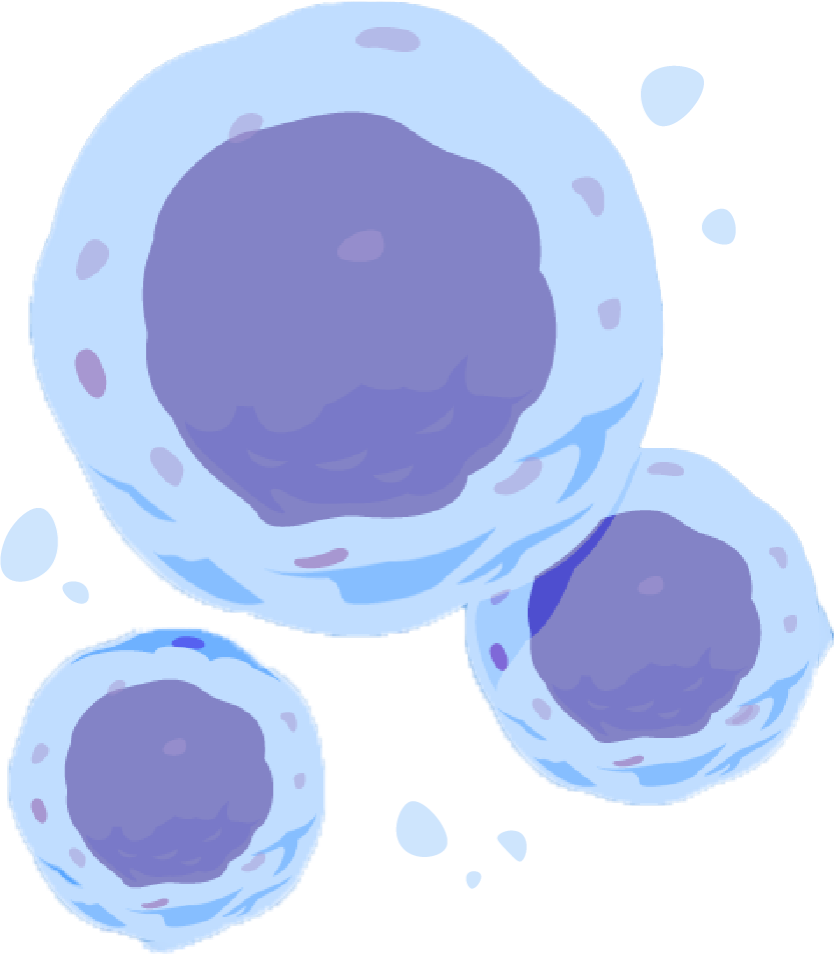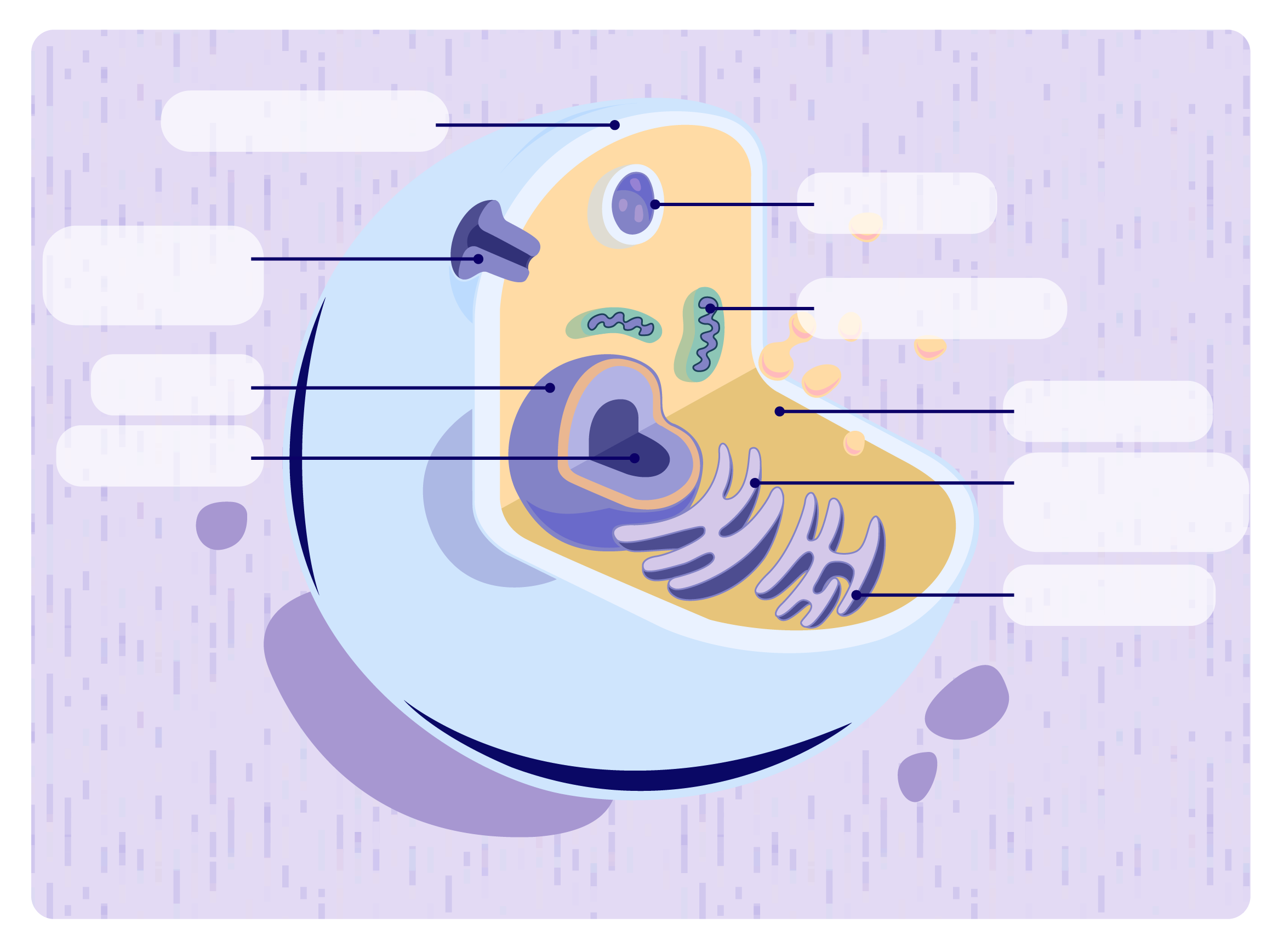01 Understanding Genetics and Your Body
Section 1
Overview of Cells

Learning Goal
To understand the essential role of cells in the human body and all living organisms.
The human body contains trillions of cells, the basic building blocks of all living things. Cells:
- provide structure for the body
- absorb nutrients from food
- convert nutrients into energy
- have other specialized functions
Cells also house the body’s hereditary material and most can make copies of themselves.1
The process of cell division is one of the key factors that influence the survival of an organism. For an organism to grow, develop, and function properly, certain types of cells must be able to constantly divide to produce new cells to replace old, worn-out cells in certain tissues.2
As shown in the illustration, cells have many parts, each with a different function. Some of these parts are called organelles. Organelles are small structures within a cell that are surrounded by a membrane and perform specific tasks within the cell.3 One of the most important parts is the nucleus, the cell’s control center. The nucleus sends instructions to the cell to grow, mature, divide, or die. It also contains DNA, the cell’s hereditary material.1 Other key parts are shown in the illustration. Hover over each part of the cell to learn more about it.
Parts of a Cell4
 Cell membrane
Cytoplasm
Endoplasmic
Cell membrane
Cytoplasm
Endoplasmicreticulum Golgi body Lysosome Membrane
receptor Mitochondrion Nucleolus Nucleus

- Cell membrane: the outer lining of the cell. It separates the cell from its environment and allows materials to go into and out of the cell.1 Also known as the plasma membrane.
- Cytoplasm: a gel-like fluid that surrounds the nucleus.3
- Endoplasmic reticulum: an organelle that helps process proteins created by the cell, and transports these molecules to their destinations inside or outside the cell.1,5
- Golgi body: a stack of small, flat sacs formed by membranes inside the cytoplasm.3 The Golgi complex packages proteins processed by the endoplasmic reticulum to be transported out of the cell.1,5
- Lysosomes: one or more compartments in a cell that help recycle materials, including large molecules.3,6
- Mitochondria: small structures within the cytoplasm that generate most of the energy for the cell.3 They are also known as the powerhouse of the cell.7 A single one is called a mitochondrion.
- Nucleus: the cell’s control center, which contains a person’s genes organized into chromosomes8,9
- Nucleolus: an area inside the nucleus that is made up of RNA and proteins. Ribosomes are made in the nucleolus.3
- Ribosomes: organelles that process or “translate” the cell’s genetic instructions to make proteins. Ribosomes make proteins by helping to link amino acids together.1,3
Additional Interesting Fact
The nucleus is surrounded by the nuclear envelope, a membrane that protects DNA and keeps the contents of the nucleus, including the DNA, separate from the rest of the cell.1
Key Learnings
Cells, the basic building blocks of all living things, play numerous essential roles in the body, including housing of the organism’s hereditary material.
Cells have many specialized parts that enable cell division, an essential process that allows an organism to grow, develop, and function properly.
Continue learning about genetics and your body in the next section
Section 2
Overview of DNA
To understand the structure and function of DNA, including how it replicates itself.
References
- Help me understand genetics: cells and DNA. MedlinePlus. U.S. National Library of Medicine, National Institutes of Health, U.S. Department of Health and Human Services; 2021. https://medlineplus.gov/genetics/understanding/basics/cell/. Accessed December 21, 2021.
- Chromosomes fact sheet. National Human Genome Research Institute; 2020. https://www.genome.gov/about-genomics/fact-sheets/Chromosomes-Fact-Sheet. Accessed December 21, 2021.
- NCI Dictionary of Cancer Terms. U.S. Department of Health and Human Services, National Institutes of Health, National Cancer Institute; 2020. https://www.cancer.gov/publications/dictionaries/cancer-terms/. Accessed December 21, 2021.
- Parts of a cell. National Cancer Institute; 2014. https://nci-media.cancer.gov/pdq/media/images/761780.jpg. Accessed June 20, 2022.
- Alberts B, Johnson A, Lewis J, et al. The endoplasmic reticulum. Molecular Biology of the Cell, 4th edition. Garland Science; 2002. https://www.ncbi.nlm.nih.gov/books/NBK26841/. Accessed December 21, 2021.
- MedTerms Medical Dictionary. MedicineNet; 2021. https://www.medicinenet.com/lysosome/definition.htm. Accessed December 21, 2021.
- Straiton J. Protecting the powerhouse of the cell. BioTechniques.com; 2019. www.biotechniques.com/biochemistry/protecting-the-powerhouse. Accessed December 21, 2021.
- NCI Dictionary of Cancer Terms. U.S. Department of Health and Human Services, National Institutes of Health, National Cancer Institute; 2022. https://www.cancer.gov/publications/dictionaries/cancer-terms/. Accessed January 3, 2020.
- SEER Training Modules, Cell Structure. National Institutes of Health, National Cancer Institute; 2022. https://training.seer.cancer.gov/anatomy/cells_tissues_membranes/cells/structure.html. Accessed January 3, 2022.